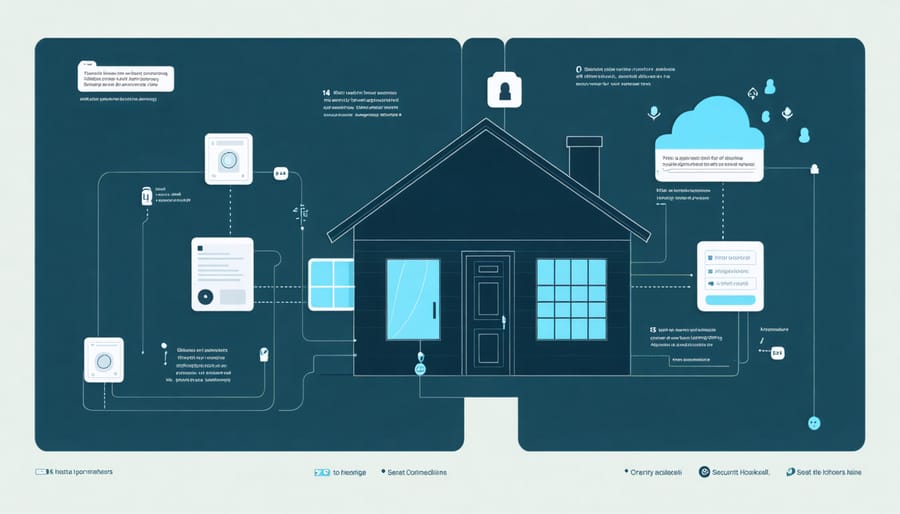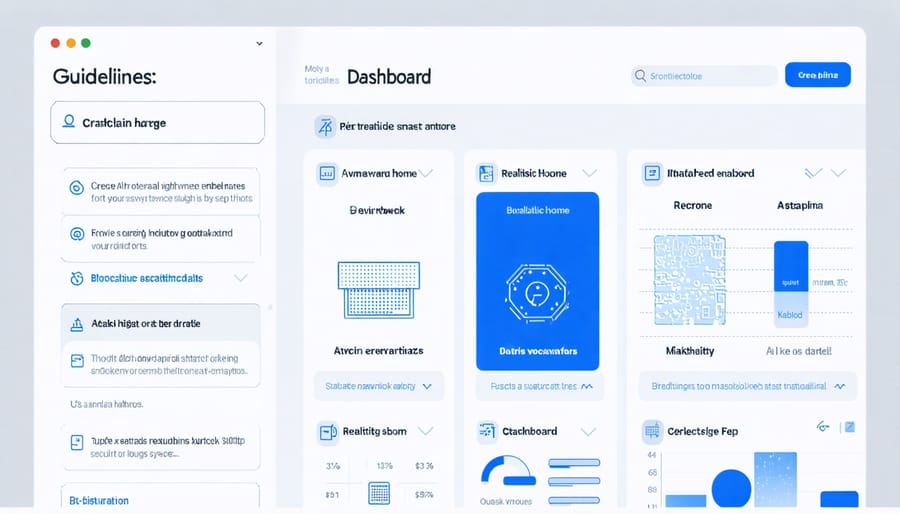Revolutionize your home’s security infrastructure by implementing blockchain technology – the same system that powers cryptocurrencies and secure digital transactions. Beyond basic smart home security fundamentals, blockchain creates an unbreakable chain of security verification that transforms how we protect our homes.
Think of blockchain as a digital fortress where every security event – from door locks to camera footage – is recorded in encrypted blocks that can’t be altered or hacked. Unlike traditional security systems that rely on central servers vulnerable to breaches, blockchain distributes your security data across multiple points, making it virtually impenetrable to cyber attacks.
For homeowners looking to future-proof their security, blockchain technology offers three game-changing benefits: tamper-proof activity logs that capture every security event, decentralized data storage that eliminates single points of failure, and smart contracts that automatically execute security protocols without human intervention. This revolutionary approach not only enhances your home’s protection but also provides peace of mind in an increasingly connected world.
Why Traditional Smart Home Security Falls Short
Common Security Gaps in Smart Homes
While smart homes offer incredible convenience, they often come with common security vulnerabilities that homeowners should be aware of. One of the biggest concerns is weak or default passwords that many users never change after installation. Smart devices often communicate with each other through unsecured networks, creating potential entry points for cyber intruders.
Another significant gap is outdated firmware and software. Many homeowners forget or aren’t aware that their smart devices need regular updates to patch security holes. Some devices even lack the ability to update automatically, leaving them permanently vulnerable to known security threats.
Data privacy is also a major concern, as many smart home devices collect and store sensitive information about your daily routines and habits. Without proper encryption and secure data storage, this information could be accessed by unauthorized parties.
Additionally, the lack of unified security standards across different smart home brands can create compatibility issues and security weak points where systems interact. This becomes especially problematic when integrating multiple devices from different manufacturers.

The Rising Threat of Smart Home Hacks
Recent data from cybersecurity firms shows an alarming 300% increase in smart home device attacks over the past year. These aren’t just numbers – they represent real families whose privacy and security have been compromised. In one notable case from 2023, hackers gained access to a family’s smart doorbell system in Seattle, using it to monitor their daily routines and eventually facilitate a break-in.
Smart thermostats, security cameras, and voice assistants have become particularly vulnerable targets. According to the FBI’s latest cyber threat report, criminals have found ways to exploit these devices not just to gather personal information, but also to create entry points into home networks. For instance, a widespread attack in early 2023 affected over 50,000 smart home hubs across North America, giving hackers control over connected devices and access to sensitive data.
What makes these threats particularly concerning is their evolving nature. Modern smart home systems often control critical functions like door locks, garage openers, and security systems. When compromised, these breaches can have serious real-world consequences beyond just data theft.
How Blockchain Transforms Smart Home Security

Decentralized Access Control
Think of blockchain-powered access control as a digital guestbook that’s impossible to forge. When you integrate this technology into your smart home security system, you’re essentially creating an unbreakable chain of records that tracks who enters your home and when. These blockchain security benefits mean that every access attempt is permanently recorded and can’t be tampered with.
Unlike traditional systems where access codes might be shared or copied, blockchain technology creates unique digital keys for each user. When someone enters your home, their digital signature is automatically recorded and time-stamped. This creates a reliable, transparent history of who’s been in and out of your property.
What makes this system particularly user-friendly is that you can easily grant or revoke access permissions through your smartphone. Whether it’s giving temporary access to your dog walker or permanent access to family members, the process is straightforward and secure. Plus, you’ll receive instant notifications whenever someone enters or exits.
The best part? The system works even if your internet connection goes down, as the access rights are stored locally on your smart locks. This means your home stays secure no matter what, giving you peace of mind while maintaining the convenience you expect from modern smart home technology.
Tamper-Proof Device Communication
Think of blockchain as a digital security guard for your smart home devices, ensuring they communicate safely and reliably with each other. When your doorbell camera talks to your smart lock or your thermostat connects to your home security system, blockchain technology creates an unbreakable chain of trust between them.
Each time your devices communicate, the interaction is recorded as a “block” in the chain, complete with a unique timestamp and encryption code. This means no one can tamper with the communication without leaving obvious traces – it’s like having a tamper-evident seal on every message your devices send.
What makes this especially valuable for homeowners is that once information is recorded on the blockchain, it can’t be altered or deleted. If someone tries to hack into your system or impersonate one of your devices, the blockchain immediately detects the inconsistency. It’s similar to how each link in a physical chain must perfectly match its neighbors – if something’s off, it’s instantly noticeable.
This technology also maintains a complete history of device interactions, making it easier to track down any security issues and ensure your smart home system is working exactly as intended. For homeowners concerned about privacy and security, blockchain provides peace of mind knowing that device communications are authentic, encrypted, and protected from interference.
Smart Contract Security Features
Smart contracts are like digital guardians for your home security system, automatically enforcing safety protocols without the need for constant human oversight. Think of them as super-reliable digital agreements that can’t be tampered with once they’re set up. These clever programs run exactly as written, eliminating human error and reducing the risk of security breaches.
For homeowners, smart contracts can automatically manage access permissions, monitor security events, and trigger responses to potential threats. For example, if someone attempts to access your home outside of authorized hours, the smart contract can automatically lock down the system, alert authorities, and send you instant notifications – all without any manual intervention.
One of the most reassuring features of smart contract security is its ability to create an unchangeable record of every security event. Whether it’s a door being opened, a camera being activated, or a sensor being triggered, each action is permanently recorded on the blockchain. This creates a trustworthy security log that can be invaluable for investigating incidents or verifying system performance.
Smart contracts also excel at managing multiple security devices simultaneously. They can coordinate your cameras, door locks, and alarm systems to work together seamlessly, creating a comprehensive security network that’s both intelligent and responsive. Best of all, these protocols can be customized to fit your specific security needs while maintaining the highest levels of protection.
Implementing Blockchain Security in Your Smart Home
Compatible Smart Home Devices
As blockchain technology continues to revolutionize home security, several innovative smart home devices are leading the way in implementing this robust security feature. Let’s explore some of the most reliable and user-friendly options currently available.
The SmartLock Pro X series stands out with its blockchain-enabled access control system, allowing you to securely track and manage entry permissions while maintaining an unalterable record of all access attempts. This smart lock seamlessly integrates with most home automation systems and offers impressive battery life.
For video surveillance, the SecureView Cam network utilizes blockchain technology to encrypt and protect your footage. These cameras ensure that recorded video cannot be tampered with, making them ideal for both security and legal documentation purposes. They offer 4K resolution and come with built-in motion detection.
The BlockGuard Hub serves as a central control unit, connecting your blockchain-secured devices while maintaining a distributed ledger of all security events. This hub works with most major smart home protocols and offers an intuitive smartphone app for easy management.
For those concerned about data privacy, the CryptoSense series of motion sensors and door contacts provides encrypted communication channels protected by blockchain verification. These sensors offer exceptional battery life and integrate smoothly with existing security systems.
Remember that while these devices offer enhanced security through blockchain technology, they should be part of a comprehensive home security strategy that includes regular software updates and strong password practices.
Setting Up Your Blockchain Security System
Setting up a blockchain security system might sound daunting, but breaking it down into manageable steps makes it much more approachable. Start by identifying your security needs and understanding your existing smart home infrastructure. This will help you choose compatible blockchain-enabled devices and solutions.
Next, select a blockchain platform that suits your needs. Popular options like Ethereum or Hyperledger offer user-friendly interfaces for home security applications. When implementing security systems, ensure your network is properly configured with a secure Wi-Fi connection and updated firmware.
Install your blockchain-enabled security devices according to manufacturer instructions. This typically includes door sensors, cameras, and smart locks. Download the associated mobile app and create a secure account with a strong password. Connect your devices to your home network and verify they’re communicating properly with the blockchain network.
Configure your security preferences and access permissions through the app. Set up multi-factor authentication for additional security, and create backup access codes for family members. Remember to regularly update your system’s software and maintain a backup power source for uninterrupted operation.
Test your system thoroughly by conducting mock security scenarios. Verify that all notifications are working and that your blockchain ledger is recording security events accurately. Consider setting up automated responses to specific security triggers for enhanced protection.

Maintenance and Best Practices
Keeping your blockchain-based security system running smoothly doesn’t have to be complicated. Here are some essential maintenance tips to help you maintain optimal security levels in your smart home:
Regular Updates: Just like any other technology, blockchain security systems need regular updates. Set up automatic updates whenever possible, and make it a habit to check for system updates at least once a month.
Backup Your Keys: Store your private keys and access credentials in multiple secure locations. Consider using both digital and physical backup methods, such as encrypted USB drives and secure paper copies kept in a fireproof safe.
Monitor Network Activity: Keep an eye on your system’s activity logs regularly. Unusual patterns or unexpected access attempts could signal potential security issues that need attention.
Password Management: Change your access passwords every 3-6 months, and use strong combinations of letters, numbers, and special characters. Consider using a reliable password manager to keep track of your credentials securely.
Regular Testing: Perform monthly security checks to ensure all components are working correctly. Test your smart locks, security cameras, and other connected devices to verify they’re properly synchronized with your blockchain network.
Clean Your Network: Regularly review and remove any unused or unnecessary devices from your network. The fewer connection points you have, the more secure your system will be.
Stay Informed: Keep up with the latest blockchain security developments and best practices. Join relevant online communities and subscribe to reputable security newsletters to stay current with new threats and solutions.
Remember, consistent maintenance is key to keeping your blockchain security system running effectively and protecting your home around the clock.
As we’ve explored throughout this article, blockchain technology is revolutionizing home security in ways we couldn’t have imagined just a few years ago. Its decentralized nature and unbreakable encryption make it a game-changer for protecting our smart homes and personal data.
The benefits are clear: tamper-proof security logs, enhanced privacy protection, and seamless integration with existing smart home devices. By implementing blockchain in our home security systems, we’re not just adding another layer of protection – we’re fundamentally changing how our security data is stored, accessed, and protected.
Looking ahead, the future of blockchain in smart home security is incredibly promising. We’re seeing the emergence of new applications that combine blockchain with artificial intelligence and machine learning, creating even more sophisticated security solutions. Imagine a security system that not only records potential threats but also learns from them, all while keeping your data completely secure and private.
For homeowners considering this technology, the initial investment might seem significant, but the long-term benefits far outweigh the costs. The peace of mind that comes from knowing your security system is virtually unhackable is invaluable. Plus, as more manufacturers adopt blockchain technology, we’re likely to see prices become more competitive and systems become more user-friendly.
As we wrap up, it’s worth noting that blockchain isn’t just a trend – it’s becoming the foundation of next-generation home security. Whether you’re tech-savvy or just starting to explore smart home options, blockchain technology offers a level of security that traditional systems simply can’t match.
Remember, the key to successful implementation is starting small and gradually expanding your system as you become more comfortable with the technology. With proper research and planning, you can create a blockchain-secured smart home that’s both cutting-edge and practical for everyday use.
The future of home security is here, and it’s more secure than ever thanks to blockchain technology. By embracing these innovations today, you’re not just protecting your home – you’re investing in the future of residential security.
